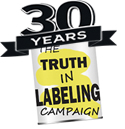MSG
Manufactured vs Natural Glutamic Acid
Ingredient Names Used to Hide MfG

Understanding Toxic MSG
According to the people who produce and sell products that contain processed free glutamic acid (MSG), and their friends at the U.S. Food and Drug Administration (FDA), there are a few, but only a few, people who will suffer adverse reactions following ingestion of MSG. Moreover, according to industry and the FDA, it will take a fairly substantial dose of MSG to cause an adverse reaction.At the Truth in Labeling Campaign, we know a different story.
MSG-sensitivity is a term used by people who react adversely to "monosodium glutamate" and/or any other ingredient that contains processed free glutamic acid (MSG). As used here, an "adverse reaction" is an unpleasant reaction that can be seen or felt by the affected person or an observer. Skin rash, nausea, migraine headache, heart irregularities, seizures, and depression are examples of adverse reactions that have been reported following ingestion of MSG. Each is a visible or observable reaction. When caused by MSG, each can be traced back to recent exposure to MSG.
We know that MSG can cause the same reactions as those caused by all drugs that affect the nervous system -- reactions that are called "side effects" when related to prescription or nonprescription drugs such as Valium, Avandia, Benicar, and Paxil. But we know very little about the mechanisms that underlie MSG-induced adverse reactions. The fairly recent discovery of glutamate receptors in many locations outside of the central nervous system (1) suggests that the readily observable toxic effects of MSG, referred to as adverse reactions, are facilitated by glutamate receptors in the mouth, lungs, intestines, and muscle, for example; and that the fate of ingested MSG is not to come to rest in the plasma as elevated plasma glutamate and from there to be excreted by the liver. Rather, it would appear that the fate of ingested MSG is to move with dispatch to any glutamate receptors available to it; and to create an adverse or toxic reaction if any one of those peripheral glutamate receptors is weak, crippled, diseased, or otherwise unhealthy.
Relevant to the toxic effects of MSG on the elderly (whose weakened blood-brain barriers would be less able to keep excess amounts of MSG from getting into their brains), there is sound science that suggests that processed free glutamic acid (MSG) may act as a "slow neurotoxin," not resulting in observable damage such as dementia until years after the MSG was ingested. The work of Dr. Peter Spencer (2-4) is particularly relevant. Mercury, for example, is a slow neurotoxin -- manifesting its toxic effects years after being ingested. It is entirely possible that the concept of a "slow neurotoxin" may be relevant to the production of human adverse reactions brought on by exposure to MSG.
Gross obesity, stunted growth, reproductive disorders, learning disabilities, behavior disorders, and retinal degeneration (possibly leading to blindness) are not classified as "adverse reactions." When caused by MSG, their roots lie in the destruction of brain cells, possibly years before gross obesity, stunted growth, reproductive disorders, learning disabilities, behavior disorders, and/or retinal degeneration are first observed. Research confirming that MSG consumed by laboratory animals causes brain lesions in the area of the hypothalamus has been replicated many times. Similarly, researchers have confirmed that when MSG is consumed by infant animals, neonates, and fetuses, the brain lesions are followed by neuroendocrine disorders such as obesity, stunted growth, and reproductive disorders.
On the other hand, research that has claimed to find that MSG is "safe" has always been seriously flawed. And relevant or not, it has always been financed, directly or indirectly, by the glutamate industry.
A third area of concern encompasses a number of pathological conditions such as addiction, stroke, epilepsy, brain trauma, multiple sclerosis, neuropathic pain, AIDS dementia, schizophrenia, anxiety, depression, and degenerative disorders such as Parkinson's disease, Alzheimer's disease, Huntington's disease, and amyotrophic lateral sclerosis (ALS). All are known to be affected by free glutamic acid. Whether ingestion of MSG plays a role in causing or exacerbating these conditions is not clear. Because glutamic acid is involved in all of them, this conglomeration of pathological conditions is often referred to as the glutamate cascade.
REFERENCES
1. Gill SS, Mueller RW, McGuire PF, Pulido OM. Potential target sites in peripheral tissues for excitatory neuro transmission and excitotoxicity. Toxicologic Pathology. 2000 28(2):277-284.2. Spencer PS, Kisby GE, Ludolph AC. Long-latency neurodegenerative disease in the western Pacific. Geriatrics. 1991 Aug;46 Suppl 1:37-42.
3. Spencer PS, Kisby GE, Ludolph AC. Slow toxins, biologic markers, and long-latency neurodegenerative disease in the western Pacific region. Neurology. 1991 May;41(5 Suppl 2):62-6; discussion 66-8.
4. Spencer PS. Guam ALS/parkinsonism-dementia: a long-latency neurotoxic disorder caused by "slow toxin(s)" in food? Can J Neurol Sci. 1987 Aug;14(3 Suppl):347-57.

